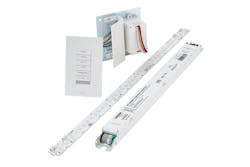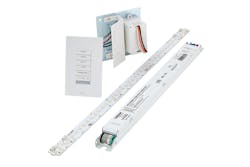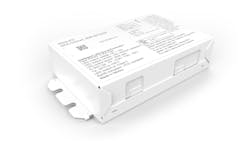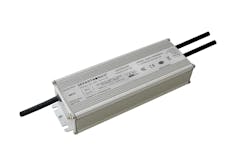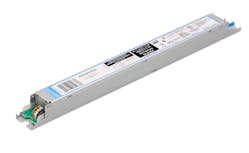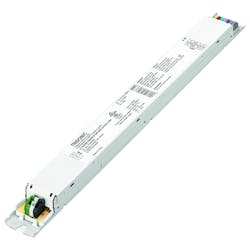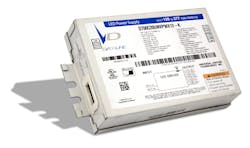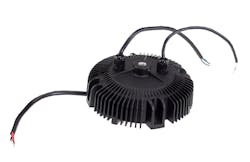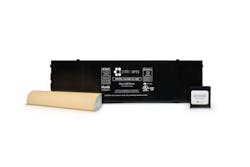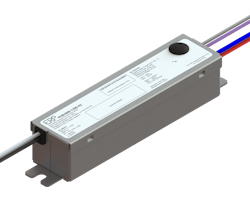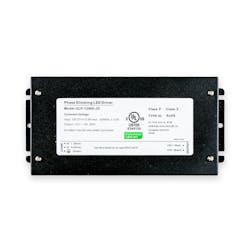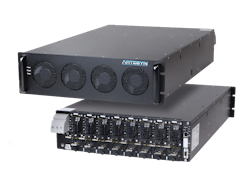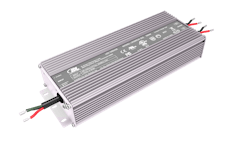The LED driver is now typically the most expensive element in a solid-state lighting (SSL) product. Five or six years back, the LEDs often represented more than 50% of the bill of materials of a general illumination fixture, but now the driver is far more costly than the packaged LEDs in most luminaires. Meanwhile, the driver design must enable flicker-free output and long life at a minimum. Most products also support dimming of some type, often with the expectation of smooth dimming to extremely low levels. Indeed, driver developers face these challenges before even getting to specialty applications. For instance, drivers for outdoor, horticultural, or hazardous applications may need enhanced environmental protection. Increasingly popular tunable-white products for applications such as human-centric lighting need multiple channels. And of course connected lighting is coming to all applications and impacting the driver. Read on for a look at some of the latest innovations in driver design.
Osram Optotronic TW LED driver
Let’s start off with a multichannel driver from Osram Digital Systems. The Optotronic TW LED driver is a two-channel design with two primary use cases. The TW suffix implies tunable white and indeed such tunable systems are the primary target of the driver. Luminaire manufacturers can quickly bring tunable products to market for advanced applications such as human-centric lighting or lighting for health and wellbeing, or simply for the ambience of tunability. Indeed, Osram bundles the driver with modular Osram PrevaLED light engines and wall-mounted controls, delivering a full turnkey set of building blocks to an SSL manufacturer. But the driver will accept DALI (digital addressable lighting interface) commands and can therefore be used with any DALI-based control system. The system supports tunable CCT and brightness with dimming supported down to 1% of full output or what Osram refers to as dim-to-off. The driver output is also programmable on a factory production line, enabling an exact match to the load requirements of any specific luminaire model, thereby simplifying the driver supply chain and inventory. The secondary use case of the two-channel design is direct/indirect fixtures where one channel controls the ambient uplight and the second channel controls downward task lighting. Photo credit: Image courtesy of Osram.
EldoLED SOLOdrive DMX models
The Acuity Brands EldoLED SOLOdrive family is a comprehensive single-channel driver offering with products ranging from 10W to 100W targeting linear and recessed lighting, and the newest products in the portfolio are 30W models with DMX support. DMX controls are most often utilized in architainment (a cross between entertainment and architectural lighting) type applications and are not always found in general illumination products. EldoLED added DMX so that designers and specifiers have a comprehensive choice of control interface within the SOLOdrive family and never have to mix and match driver products. Moreover, DMX enables manufacturers to ship preconfigured products — for instance, to meet regulatory policy such as California Title 24. The new Model 30B-M1Z0X and 30S-M1Z0X feature a 130×72.4×29- mm form factor with bottom- or side-fed wiring. The SOLOdrive family further features Acuity’s LEDcode technology that will enable a manufacturer to combine the drivers with most any wireless connectivity module including Acuity nLight controls and Bluetooth-Mesh-based modules such as those from Casambi. EldoLED offers specific models with DALI and 0‒10V controls. All of the SOLOdrive products feature the Acuity Hybrid HydraDrive dimming technology for flicker-free dimming to dark. Photo credit: Image courtesy of Acuity Brands.
Inventronics Long-Life drivers
As mentioned at the introduction of this article, some applications demand special attention to long life even given the fact that LED technology offers inherent longevity relative to legacy sources. The driver does remain the most likely element to fail in an SSL system, so drivers optimized for long life are important in applications where harsh environmental conditions are present and/or applications where maintenance is prohibitively expensive or difficult. Examples include street lights, industrial high-bay lights, outdoor area lights, tunnel lights, and more. Those are the applications Inventronics targets with its Model EUD-DTL/DVl drivers that the company has generically referred to as the Long-Life portfolio. The offering ranges from 90W to 240W for street lights that would span residential roads to busy collector highways and even freeways, for instance. The company offers a 10-year warranty on the products and delivers the reliability via the elimination of electrolytic capacitors and other techniques in the design of the driver’s printed-circuit boards (PCB) and transformers. For example, additional coating is applied to transformer wires and the PCB is based on a material designed for operation at 170°C. The drivers also support many advanced features such as multiple options for controls and a 12V auxiliary DC output that could power a controller/connectivity module. Photo credit: Image courtesy of Inventronics.
Signify Advance Xitanium SR FlexTune LED driver
The new Signify Advance Xitanium SR FlexTune driver was prominently demonstrated at LightFair International including in products from Signify’s OEM customers. Like the Osram driver discussed previously, the Signify FlexTune technology is a two-channel system intended primarily to mix warm- and cool-white LED channels. The SR suffix in the model name stands for Sensor Ready and the former Philips Lighting had introduced the SR concept not too long before our last driver roundup back in 2016. Signify has evolved the concept somewhat, especially in being a devout advocate of industry standards that cover what Signify has referred to as the intra-luminaire interface. The two-wire SR interface is based on the emerging ANSI C137.4 standard that is an evolved version of DALI capable of carrying power and data over the same wires. We summarized that intra-luminaire evolution in a recent feature article on how such standardization inside the fixture can enabled smart connected lighting. Signify offers a number of its own modules that combine sensors and connectivity for use with the SR drivers; the technology also supports modules from third parties. Signify sells the Philips-branded EasySense line with models spanning simple autonomous controls in a room to fully-connected floors and buildings. The 40W driver pictured here supports dimming to 1% and advanced Internet of Things (IoT)-type features such as monitoring the energy that the luminaire uses and running preventive- maintenance diagnostics. Photo credit: Image courtesy of Signify.
Tridonic dimmable LED drivers with NFC technology
The Excite (EXC2) dimmable LED drivers are available in a range from 20W to 85W and support 0‒10V dimming as a standard feature. And like many driver manufacturers, Tridonic has sought to simplify the supply-chain and inventory-management logistics for its customers by making the output of the drivers programmable, thereby reducing the number of different models required. Tridonic utilizes nearfield communications (NFC) to enable the programming of current output in 1-mA steps. The company makes it easy to leverage NFC wireless technology in its devices. By using the complimentary Tridonic companionSUITE software, all features of the driver are visible to the manufacturer and can be programmed for single or multiple units. For example, wireless transfer of LED driver settings can be delivered to up to 20 drivers in a box. Moreover, the software tool can be used to analyze errors in the event of a return, in addition to defining LED driver parameters and transferring parameter settings in production runs. Of course, like most drivers covered here, Tridonic’s EXC2 Series also addresses connectivity and lighting controls. The drivers supply 24 VDC auxiliary power for wireless control modules and sensors. The EXC2 family is one of a number of Tridonic SSL technologies that were discussed in a LightFair booth video. Photo credit: Image courtesy of Tridonic.
Universal Lighting Technologies Touch to Tune
Programmability can extend far beyond the luminaire factory as a key feature as well. Universal Lighting Technologies, a Panasonic brand, uses programmability — or what the company refers to as tuning — to simplify the replacement driver market. With the driver identified as the most likely point of failure in a luminaire, large SSL installations will invariably suffer some failures. Facilities managers would find it much cheaper to replace a failed driver than to replace the luminaire. Universal offers field programmability across its Everline PW Series of drivers that span 20W to 80W. Generally, distributors of the products will support the use of a smartphone-based Touch to Tune app to set the replacement driver to mimic the original. The software can set not just maximum output levels but also the full dimming curve, dim-to-off voltage, and minimum dim current. Universal recommends that distributors need to carry only seven driver models to handle the most common replacement scenarios. Photo credit: Image courtesy of Universal Lighting Technologies.
MeanWell HBGC-300 High Bay driver
Sometimes it’s not the exotic but rather the mechanics that matter in drivers. There are untold numbers of circular high-bay high-intensity discharge (HID) fixtures with reflector optics installed. The simplest path forward to retrofit such lighting can often be a one-forone replacement. Such a retrofit scenario is the force behind the MeanWell HBGC-300 High Bay driver. As you can see in the photo, the 300W driver integrates the heat sink and is designed to sit atop an LED light engine and reflector. The product includes PFC (power factor correction) and is up to 94.5% efficient depending on output current. But just because the driver is intended for replacement of a relatively low-tech type of HID fixture, that doesn’t mean it’s lacking in newer SSL features. The product optionally supports dimming via DALI-2 and traditional 0‒10V controls. Typical installation settings will include big-box retailers and industrial manufacturing and warehouse facilities. Photo credit: Image courtesy of MeanWell.
Optic Arts VintageDim 2
Not all dimming and controls are about traditional luminaire form factors. Indeed, LED strips are being widely used in places ranging from retail to hospitality to hidden coves in high-end residential settings. Increasingly, such strips offer more than just dimming. As the VintageDim 2 name applies, the two-channel driver from Optic Arts has the ability to provide dim-to-warm functionality with a single 0‒10V control input. In such a scenario, the CCT would typically go from 2700K at full output to 1800K at minimum output. If two 0‒10V controls are available, then a user can separately set CCT and dim level. Moreover, Optic Arts has also gone down the path of using smartphones to further customize the output of an SSL product. Dimming curves come preset, but the user can program any desired dimming and CCT curves desired using the smartphone app. Beyond the default presets, the company loads a number of other preprogrammed scenarios into the app. Note that just as this issue of our magazine was going to press, we learned that Luminii LLC was acquiring Optic Arts. Photo credit: Image courtesy of Optic Arts.
ERP Power PHB Series
With the discussion about networked controls, we do sometimes forget about the legacy dimmers installed around the world. Furthermore, there are multiple flavors of such dimmers. That realization led ERP Power to develop the PHB series in 30W (PHB30) and 50W (PHB50) versions. The products include a microcontroller- based driver circuit that can adapt to input from the standard and ubiquitous triac dimmer, to more advanced ELV (electronic low voltage) phase-controlled dimmers, or to 0‒10V controls. That trio of options makes the product compatible with the largest segments of the installed base of dimmers. ERP also touts the size of the dimmer as a huge advantage: It measures 103.5×26.2×23.85 mm. It comes with a choice of side or bottom leads. The company has also addressed the need for smaller networked drivers. The DAL series is in a similar form factor to the PHB Series but offers a DALI-2 input. The company asserts that it is the smallest DALI-2 driver on the market. Photo credit: Image courtesy of ERP Power.
Environmental Lights Universal Phase Dimming drivers
Following along with the theme of the ERP product, Environmental Lights also offers drivers that strive for broad compatibility with legacy dimmers. In the case of its Universal Phase Dimming products, the company says the products support CFL/LED dimmers (a designation used by some dimmer manufacturers), ELV dimmers, and MLV (magnetic low voltage) dimmers. Moreover, there is another aspect to the use of the word universal. The drivers work with input ranging from 120‒277 VAC at 50‒60 Hz, meaning the units will work with power grids around the world. The drivers output a 410-Hz, pulsewidth-modulated signal to an LED light engine. The product was nominated for the 2019 Sapphire Awards and Environmental Lights won a Sapphire Award for its HyperFlex 2835 LED Strip Light. Photo credit: Image courtesy of Environmental Lights.
Artesyn Intelligent High Power System
Now, let’s move in our driver roundup to a product that doesn’t look like a driver and a form factor that looks like it belongs in a data center. Indeed, that’s the origin of the Artesyn iHP (Intelligent High Power) System. Actually, the potential of a central power conversion from AC to DC and DC distribution to lighting is something we have written about before as having possible efficiency advantages and integrated control capabilities. Artesyn is targeting a number of applications with this distributed architecture, and one is LED-based horticultural lighting. The central power converter pictured can be located remotely from the lights and out of the harsh environment of the growing chamber. Meanwhile, the 24,000W system is a good match for cultivars such as cannabis that need high energy levels, especially during flowering. The system has eight outputs that can power individual growing nodes used as an alternative to HID lights in many cannabis grow operations. We will learn more about horticultural lighting and technology topics at our Oct. 31 HortiCann Light+Tech Conference in Denver, CO. Photo credit: Image courtesy of Artesyn.
SL Power LE500 Family
Horticultural lighting is also one target application for the SL Power LE500 Family of AC/DC power supplies. Drivers and power supplies are very similar in nature, although drivers most often generate the constant current needed by LEDs for consistent illumination. This 500W power supply would not connect directly to an LED light engine but would generally power multiple DC/DC converters located near LED loads. You will find such implementations in horticulture, and in industrial- and arena-lighting applications. The LE500 products accept a universal 120‒277V input and can be specified with 12, 24, or 48V output. Efficiency is around 92‒93% depending on the input voltage. The product is designed for harsh environments with an IP67 ingress protection rating (see one of our prior articles for more on IP ratings at http://bit.ly/2zyk4Sx). The product can survive immersion in water to 1m in depth for 30 minutes. And SL Power says the unit is 30% smaller and offers double the lifetime of competitive 500W power supplies. Photo credit: Image courtesy of SL Power.
Hubbell Lighting Components LBU10-P Series emergency drivers
Another specialty area of the LED driver sector is the emergency sector comprising drivers that enable continued operation of some lights within a facility in the case of a power outage. Hubbell is one of several companies with products in the area with the LBU10-P Series and related products coming from the organization that was previously called Thomas Research Products. The driver can provide 90 minutes of emergency lighting, enabling orderly egress of people from a facility in a power outage. Hubbell also said the drivers meet or exceed stringent California Title 20 energy-efficiency requirements. The drivers feature a universal 120‒277V input that ultimately charges a nickel-cadmium battery. An automatic transfer circuit swaps a luminaire to emergency mode when power is lost. The product is rated for dry and damp locations. A UL 924 classification means that the driver can be factory installed or retrofitted into a luminaire in the field. The driver includes a test switch and a visible charging indicator. Photo credit: Image courtesy of Hubbell Lighting Components.
Thinking outside the box
Having spent some time considering the advanced capabilities of the latest LED drivers, what’s in your lineup that deserves recognition? The LEDs Magazine Sapphire Awards strives to reward innovation and quality across many SSL and enabling technology categories, including standard LED drivers and emergency-related models, ICs and other electronic components, and smart/connected enabling technologies for networked lighting systems. Enter your best and brightest before Oct. 1, 2019 at http://bit.ly/2yXkDEX.
